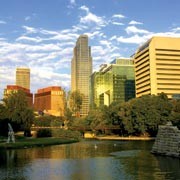Most visitors come to Omaha because there’s some other reason for them to be in the city,” says Buster Brown, Omaha’s longtime city clerk and resident man-about-town. “But once they’re here, they really enjoy it. It’s not a big city but it’s big enough that you have all the options of a large city without all the problems.”
Many folks, when they think of Omaha, still perceive it as a dusty cowboy town with cattle roaming the city streets and swinging doors on the saloons. That view of Omaha is about a century out-of-date.
Today, Omaha is a thriving town of 425,000 that’s home to billionaire Warren Buffet, scores of high-tech startups and nearly a dozen Fortune 500 companies. It has a vibrant arts community and boasts a sparkling new $291 million convention center, the Qwest Center. The facility opened in September 2003 and boasts more than 1.1 million square feet, including a 194,000-square-foot exhibition hall, more than 62,000 square feet of meeting space and an adjacent 18,300-seat arena. The Qwest Center site includes 4,500 parking spaces and is connected by a skywalk to the 450-room Hilton Omaha.
Omaha has come a long way from its early cowboy days. Early in the 20th century, Omaha had a reputation as an “open” city, where practically anything was permissible as long as you got away with it. Under the administration of Mayor “Cowboy Jim” Dahlman, Omaha grew into a two-fisted Midwest powerhouse, earning the nickname “Gateway City of the West” for its importance as a railroad hub.
From the start, the Omaha area took on a very particular flavor: beef. For decades, Omaha housed the world’s second-largest stockyards and meatpacking industry (behind only Chicago) and the fifth-largest grain and milling center.
“When I first came to Omaha in 1967, there were still meatpacking plants and there was even large stockyards in south Omaha,” Brown recalls. “All that’s gone now. But there are lots of new industries in its place.”
Today, Omaha is still a railroad center, but the real growth industries are high tech, agribusiness and finance. The city is headquarters for a surprising number of companies for a town of its size, including Berkshire Hathaway, Union Pacific, The Gallup Organization, TD Ameritrade, Conagra, and, yes, Mutual of Omaha. In fact, Omaha ranks eighth among the nation’s 50 largest cities in both per-capita billionaires and Fortune 500 companies.
Newsweek named Omaha one of the country’s Top 10 high-tech havens, and scores of large technology firms have headquarters or major operations in the city, including First Data, PayPal and LinkedIn. It’s a far cry from the days when Omaha made its fortune processing cattle.
Warren Buffet, the world’s second-richest man behind Bill Gates, is a long-time resident who’s acquired the nickname the Oracle of Omaha.
“Warren Buffet turned a lot of Omaha people into millionaires when they invested with him,” Brown says. “And those people have been very good to the city. They’ve really donated a lot of money to the arts and culture in the area instead of just leaving their money to their kids.”
Omaha even has its own signature sound. Saddle Creek Records is an independent record label based in Omaha that’s gained a national following. The label was founded in 1993 by Omaha natives and is named after Saddle Creek Road, a street that cuts through midtown Omaha. Saddle Creek Records is the flagship of a style of music that’s come to be known as “The Omaha Sound,” characterized by a country twang, although more electronic sounds have found their way into the music of late.
But don’t worry, Omaha hasn’t completely shed its cowboy/meatpacking past. You’ll see plenty of the town’s past when you stroll through the Old Market, a 12-block area of downtown featuring old brick warehouses now housing upscale shops and restaurants.
It’s still a cattle call, but a much more orderly one.






